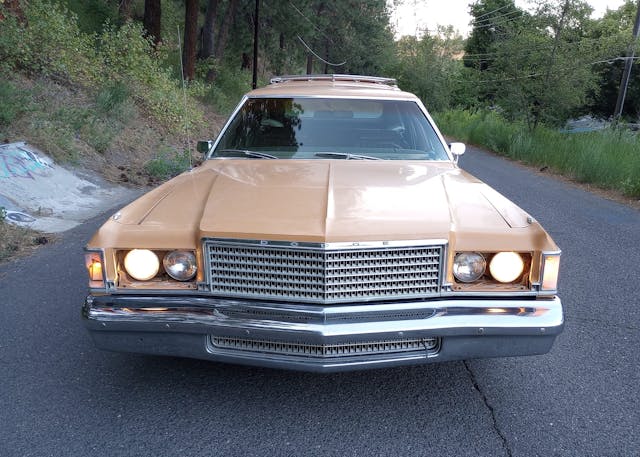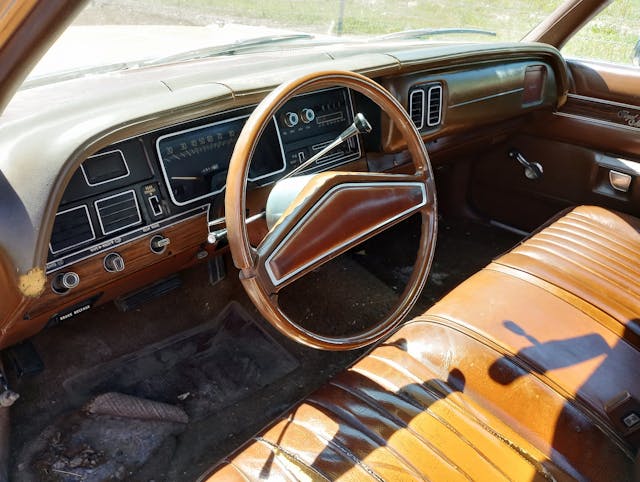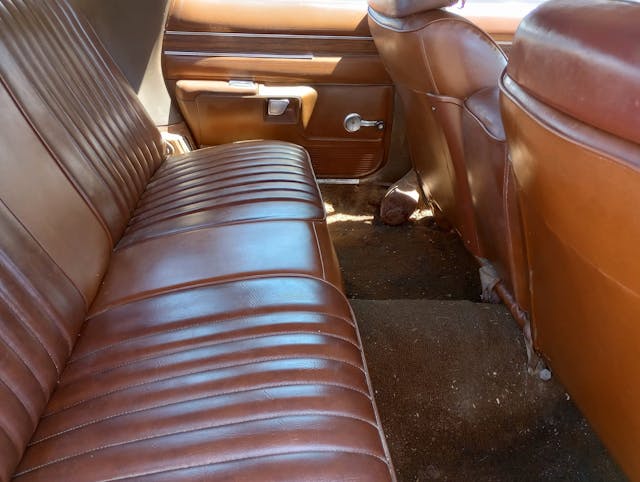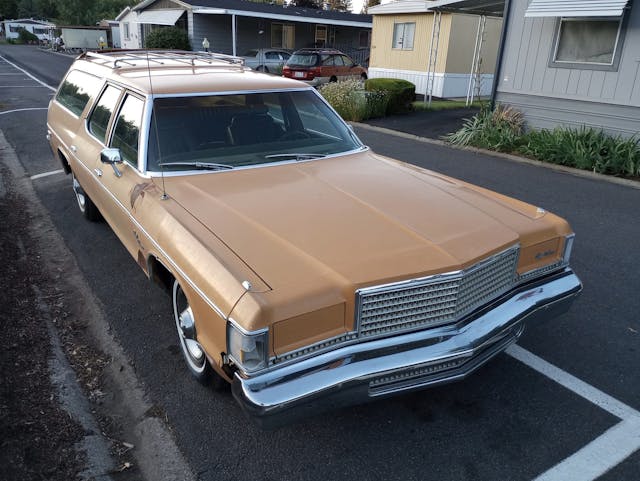1976 Dodge Royal Monaco wagon: Hen’s tooth

Remember the Dodge Monaco and Royal Monaco? I bet you do if you’re of a certain age—a certain age that, like me, remembers the TV show Hill Street Blues and the classic 1980 movie, The Blues Brothers. I love The Blues Brothers. It’s my favorite movie, and I’ve probably watched it 50 times. So I knew all about Dodge Monacos from an early age.

The Monaco was originally meant as a competitor to the Pontiac Grand Prix, which itself was a super-deluxe version of the Catalina two-door hardtop. Chrysler Corporation responded with the 1965 Monaco. Like the GP, it came only as a two-door hardtop and had an extra-snazzy interior with rattan door panel inserts, bucket seats, and a center console.

But that only lasted for a single model year. Starting in 1966, the top-of-the line coupe, now named “Monaco 500,” was supplemented with a slightly less-loaded two-door hardtop, four-door hardtop, and four-door pillared sedan. Oh, and there was now a glitzy, wood-sided Monaco wagon.

The Monaco remained the top-of-the line full-size Dodge through 1973, with the Polara sedans, coupes, and wagons being one rung below it, much like the LTD and Galaxie 500 over at Ford, or the Caprice and Impala at Chevrolet. But starting in 1974, the Polara disappeared, and it was all Monaco, all the time. Now there was a base Monaco, mid-level Monaco Custom, and the top-of-the-roost Monaco Brougham.

Chrysler Corporation was very popular with police departments nationwide, so many, many Monaco and Fury police cars were seen in the ’70s, both on the streets, on TV, and in movies. But mostly what you saw were sedans. So, have any of you fine folks ever seen a 1974–77 Monaco wagon?

If not, don’t feel bad. I’ve never seen one. Not as a kid, not at car shows or cruise ins, not anywhere. Until my pal Jason Bagge, “The Brougham Whisperer,” found this one late last spring.

It was rough, rusty, and dusty, but it ran, and the price was right, so he nabbed it and began sprucing it up. When I asked him what he knew about the car’s history, he said all he knew was that the car was sold new in Edmonton, Alberta, so it was a Canadian car. It went from Edmonton to California, then to Montana. And that’s all Jason knows about its journey.

As per usual for a Royal Monaco, it does not have air conditioning; indeed, it is rather sparsely equipped for a car with such a fancy-looking front end, complete with hidden headlights. Though it does have the optional Premier wheel covers.

One interesting interior feature of these cars (and also the 1974–77 Plymouth Fury/Gran Fury, 1974–75 Imperial, and 1974–78 Chrysler New Yorker/Newport) was the centrally-located glove compartment. Also, that chrome-rimmed square above the ventilation ducts to the left of the speedometer are where the clock would go if—you ordered one. This wagon doesn’t have it.

For whatever reason, Dodge full-size wagons were not very popular. In 1976, the Monaco came in four versions: a base two-seat Monaco, two- and three-seat Royal Monacos, and a three-seat Royal Monaco Brougham wagon. Production was 1116 Monacos, 923 two-seat Royal Monacos, 1429 three-seat Royal Monacos, and 2480 Royal Monaco Broughams. Yes, the most expensive wagon, the Brougham, was the most popular.

The previous year, 1975, a total of 8019 Dodge wagons (in all trim levels) were built. Which is crazy, because the same year Ford built 6930 Custom 500 wagons, 22,935 Country Sedans, and 41,550 Country Squires. And Chevrolet built 58,529 full-size wagons, from the bottom-rung Bel Air to the top-trim Caprice Estate.

The 1976 Royal Monaco two-seat wagon had a base price of $5241 ($28,100 today) and had a curb weight of 4915 pounds. While sedans and coupes came standard with a 318-cubic-inch V-8, all wagons came with the 400 V-8, a 4.34 x 3.38 bore and stroke, and 175 horsepower. The Elwood Blues-approved 440 V-8 was optional.

As the ’76 Monaco brochure stated, “A full-sized wagon should be able to do a day’s work and then take you out on the town in style … all models feature power steering, power front disc brakes, automatic transmission, and 400-cubic-inch V-8 engine. Choose a Monaco wagon for ’76: You’ll get the uncommon in luxury and convenience, plus practical full-sized utility.”

It sounded good, and the Monaco long-roofs were sharp in my opinion, especially the wood-sided Broughams, but as previously mentioned, both Ford and Chevy trounced them in the sales charts, particularly Ford. There was a reason they were called “The Wagonmaster” at the time. Granted, Dodge was closer to Mercury and Oldsmobile at the time, but even Plymouth sold around 16,000 full-sized wagons in 1975, still way below Ford and Chevy.

Jason’s survivor is in the very ’70s color combination of what appears to be Saddle Tan (per my ’76 Monaco brochure) with a dark brown vinyl interior. Other available colors in 1976 included Eggshell White, Deep Sherwood Metallic, Spanish Gold Metallic, Powder Blue, Silver Cloud Metallic, and Vintage Red Metallic. Wagon wheelbases were 124 inches; sedans and coupes had a shorter 121.5-inch span.

As I write this (in June 2023), Jason is attempting to sell it. He did some work on it but didn’t want to get too deep into it, as he essentially bought the car as a U-Haul for a one-time use, then sell it off. A rare birdie any way you slice it, only 923 Royal Monaco two-seat wagons were built in the U.S. in 1976—and this is a Canadian-built version, one of 547, according Jason. Hopefully it goes to someone who will appreciate it and enjoy it!

***
Check out the Hagerty Media homepage so you don’t miss a single story, or better yet, bookmark it. To get our best stories delivered right to your inbox, subscribe to our newsletters.


To paraphrase Jack Nicholson as the Joker, “Where does Jason find all these wonderful toys?” Very interesting that the rust mites are only begging to feast on the car. I grew up in a town with a single new car dealer (Dodge-Plymouth-Chrysler-Jeep) and versions of this car filled almost every driveway with a few Darts-Valiants-Dusters sprinkled in. I can verify that they were the go to car for the local and highway patrol. One night a full dress Monaco came in sounding like a race car, the trooper had drug the exhaust off from the header back chasing some shiner down a dirt road. Had to have a new exhaust system before morning when the barracks Sargent came in, it was a late night at the Texaco station. But I digress, interesting that this car has the optional front fender turn indicators and a tilt wheel and not much else. Oh Jason good luck finding a front right turn signal lens. What the rust mites did not get. And this era Chrysler Corp products rusted on the show room floor, the crushers got the rest.
My Dad had a 1974 Dodge Monaco Custom Wagon with the 400 2 barrel automatic combo. It was a 3 seat wagon in powder blue. The car never ran right, couldn’t ever get that fixed. It also ate starters for lunch and rust was a major issue. Chrysler was already in financial trouble and quality control was really lacking. There was a reason that sales on these and the Plymouth Fury were low. Most were junk. We nicknamed ours “The Blue Goose”.
I’m a Mopar freak, but with what I experienced with Dad’s Monaco, sorry I wouldn’t touch this with a ten foot pole.
A little rough, but still a pretty cool car. Like many, I’m a little nostalgic for the long roofs. I wonder if Schumacher makes a engine mount swap kit for these. The subframe might be the same as the Cordoba/Magnum setup. A 3rd gen Hemi with an eight speed behind it could breathe new (fuel economy) life into this thing, while still keeping its utility.
Ah, the old family wagon; my first car was hand me down ’66 Plymouth with 383 V8, P/S, P/B and A/C! The thing regularly carried not only family of 6 and the 100 lb. German shepherd, but many a 4X8 sheet of building material before it was turned over for my 16-year-old stupidity. Even though the car was less than 100K miles and only 7-8 years old, I did manage to smoke the low/reverse band in the old torque-flight automatic transmission, and that was the first cheap lesson learned, and why I still don’t care for anything but manuals to this day. Despite unibody construction, they were pretty durable cars, except in the rust belt where everything is destroyed in less than 10 years. I sold it a few years later so as to improve my self-image in the life quest of more, newer, faster, better, etc., for the $300 it had cost me for the transmission repair.
I have a 1965 Dodge Monaco
MOPAR or No car. Would love ro have a early 80s Grand Fury or Diplomat police cruiser.
When I was 16-17 years old we had a Royal Monaco wagon, gold & gold. We lived near Peterborough, Ontario in Canada; purchased from JJ Stewart Motors in Norwood, Ontario. My first ever excursion onto the 401 outside of Toronto was driving that car! My dad also let me take turns driving it with him on a family vacation to Florida (1978?). Good memories with that wagon!